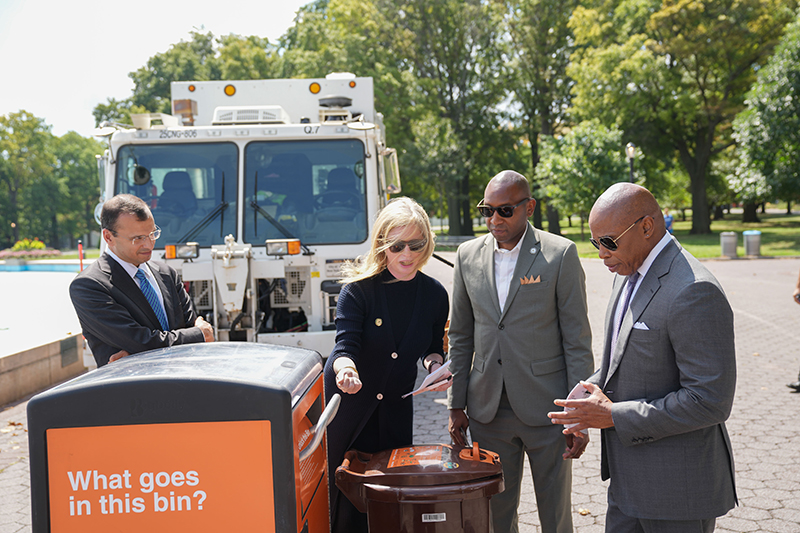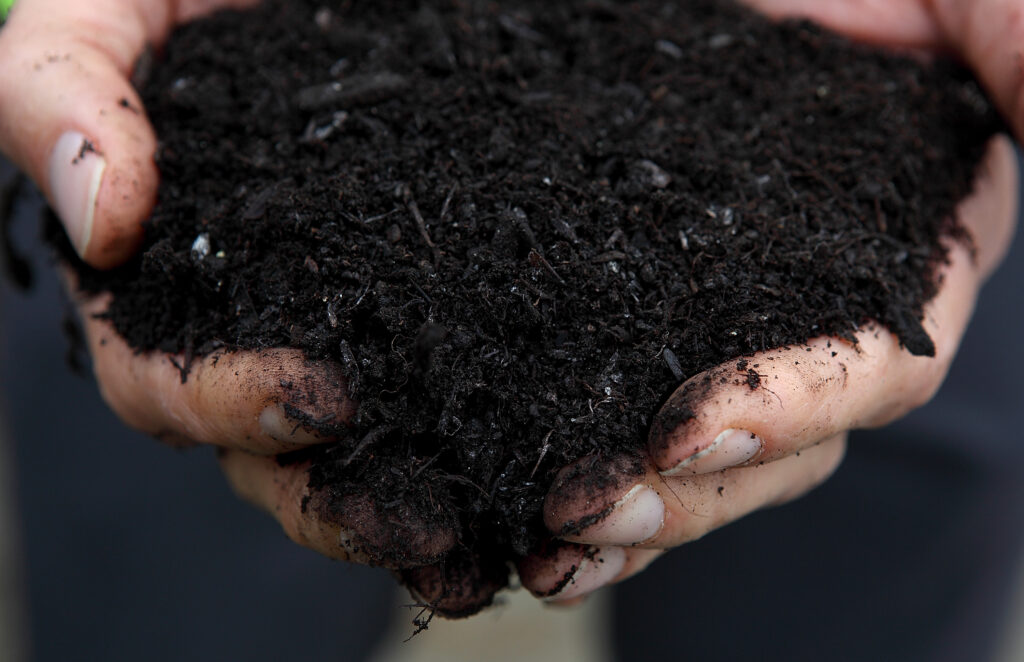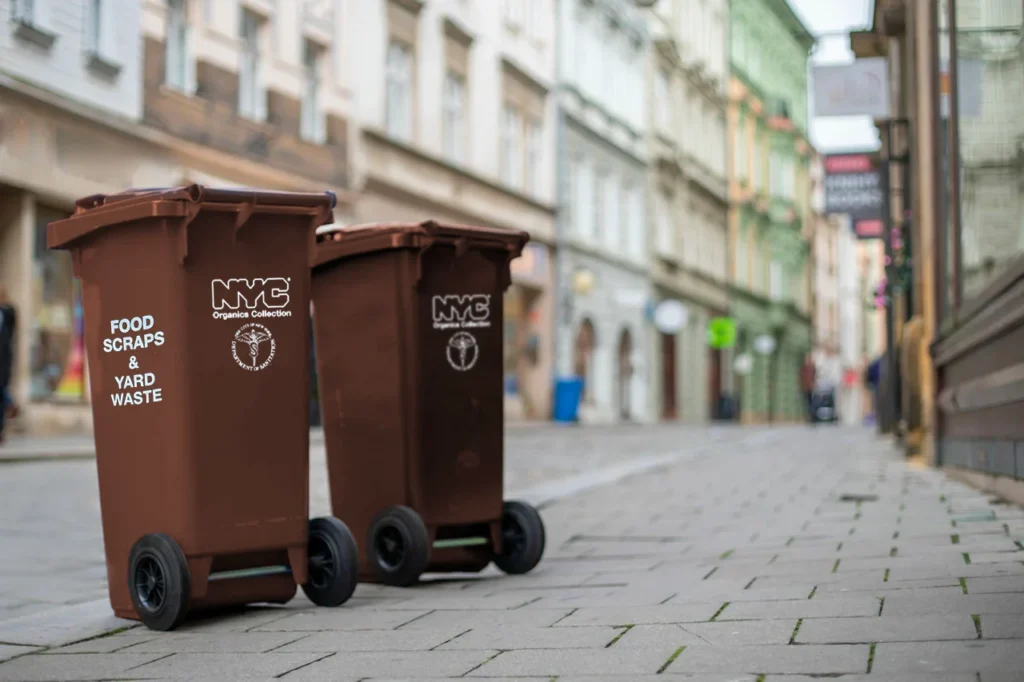Compost Cops Are Coming to New York City: Will Policing Food Scraps for Eight Million People Be Worth It?
As of April 1, the city will start issuing fines to New Yorkers if they’re found to be dodging the city’s mandatory composting policy.

In 1990, just one year after New York City made recycling the law, Officer Richard Stasio, wearing a badge and a blue uniform, knocked on the front door of a two-family home at the Wakefield section of the Bronx and asked to speak with the owner.
The owner answered the door wearing very little, other than a look of bewilderment upon seeing the burly cop and his partner standing in front of him, the New York Times reported in a 1990 story.
Were the cops there to question him about a crime? Or was there something more urgent that required two cops to pay him a morning visit?
“Your garbage contained 17 metal cans, one glass bottle and approximately two inches of unsoiled newspaper,” said Officer Stasio. The owner was handed a $25 fine for his offense.
The men were from the “Sanitation Police,” whose job it was to ensure that New Yorkers were separating their glass from their plastic and paper waste, as had been mandated by Local Law 19. Enforcing the law was proof that recycling had become a “serious” business in the city.
“I’m sure 10 or 15 or 20 years from now, when we have changed the culture of waste in New York City, we’ll be asking how could we not be recycling,” the Sanitation commissioner at the time, Steven Polan, said in 1990.
Thirty-five years later, the jury’s still out on whether the city’s recycling efforts are effective. But New York City has now mandated a new disposal law, this time for composting. Starting April 1, the city will send out summonses, ranging from $25 to $300, to those who don’t separate their food scraps, yard waste, and compostable packaging from their garbage and recycling and put it in a distinctive brown mini-bin to be collected by sanitation workers.

“We are waging war against climate change. Our weapons are your banana peels, rotten tomatoes, and stale bread,” said the former deputy mayor of operations, Meera Joshi, in October 2024.
The city plans to repurpose the food waste into either renewable energy used for heating or soil for city parks and gardens. City officials say that food waste accounted for 20 percent of the city’s “greenhouse gas” emissions in 2023.
The alternative to composting is that food waste will “go to a landfill and become nothing but rat food and greenhouse gasses,” said the deputy commissioner for public affairs at the Department of Sanitation, Joshua Goodman.
Composting became a citywide, compulsory option last October, but the citywide capture rate for composting was only 3.7 percent in 2024. The big question is whether fines alone are enough to get New Yorkers to fundamentally change how they discard food waste.
“Enforcement is important for increasing our capture rates and diverting (waste) from landfills,” said a city council member, Shaun Abreu, a Democrat and the chairman of the council’s committee on sanitation and solid waste management.
“That being said, we’ve seen how long it’s taken recycling rates to go where they are today,” he added.
The city’s “recycling diversion rate” rose to 13 percent in 1997 from 5.4 percent in 1992. The city in 1997 added milk cartons, bulk metal items, and juice boxes to its designated materials, according to a 2004 City Sanitation report. Last year, the curbside and containerized diversion rate was 17.5 percent, according to a 2024 Zero Waste Report.
In 1996, John Tierney, writing for the New York Times, sparked a small firestorm when he wrote, in a cover article for the Time’s magazine, that recycling programs “may be the most wasteful activity in modern America: a waste of time and money, a waste of human and natural resources.”
“They offer mainly short-term benefits to a few groups — politicians, public relations consultants, environmental organizations, waste-handling corporations — while diverting money from genuine social and environmental problems,” wrote Mr. Tierney.

Almost 30 years later, with the city having settled into a recycling rate below 20 percent, the debate continues over the efficacy of recycling versus the cost. Similarly, the tangible benefits of composting remain unclear.
The debate may only be beginning about whether achieving a double-digit diversion rate – especially with an elaborate and expensive composting program – will make any meaningful difference in carbon dioxide emissions.
And then there is the question of whether New York City can competently handle the food waste its citizens dutifully put in the brown bins. Some environmental groups have in recent years accused New York City of “greenwashing” in its composting program.
California passed a law in 2016 that aimed to divert 75 percent, or 20 million tons, of organic waste from statewide landfills by 2025. However, between 2014 and 2021, organic waste levels in landfills dipped by just two million tons per year, well short of the intended goal.
An estimated 75 percent of residential waste in New York City consists of materials that can be diverted from landfills with current city-managed programs, according to a 2023 Sanitation Department report.
Since the city mandated composting (without enforcement or fines) when it passed Local Law 89 of 2023, it saw a 65 percent increase in compostable material diverted from landfills, according to a city Sanitation spokesman.
But the actual amounts of waste being composted remains very small, and participation rates are low. Experts blame this on the effectiveness of the Sanitation Department’s outreach education efforts.
“In any city, a 5 percent capture rate would be considered low,” waste expert Samantha MacBride noted in her report. At 3.7 percent, it’s evident that the Sanitation Department “lacks a clear coherent strategy to address persistently low capture rates,” she added.
Come April, buildings with one to eight units will face fines of $25 for the first offense, $50 for the second, and $100 for all subsequent violations (buildings with nine or more units face steeper penalties, going as high as $300 for repeated violations).

While the Sanitation Police are still in force, totaling 130 in number, the bulk of the enforcement will be left to the city’s 203 sector supervisors, who will hunt for composting violations by keeping an eye out for “context clues” like smells, visible food, and rodents.
“They’re not necessarily opening the bag, but using context clues from outside the bag to know what’s inside it,” said Mr. Goodman during a City Council hearing earlier this week.
How effective this will be is unclear. The vast majority of New York City residents live in apartments, and much of the garbage from apartments is double bagged – bags of garbage are put by building staff into much larger, heavy duty garbage bags that are sealed and left out on the curb. This could make it difficult for even the savviest sector supervisor to identify the unlawful presence of food waste.
Sanitation officials insist the fines themselves are not meant as a cash grab. “Our goal is to try to increase diversion. We’re not, you know, looking for revenue on any of this,” the sanitation commissioner, Javier Lojan, told the City Council.
The head of the New York Apartment Association, a lobbying group that represents the city’s property owners, Kenny Burgos, says that this “well-intentioned but poorly executed” policy will do little in forcing tenants to compost regularly and correctly.
A big reason for that is the city’s current educational and awareness campaign. “Almost no one knows this is coming out on April 1st,” said Mr. Burgos.
Mr. Goodman told the New York Sun that the Sanitation Department spent $1 million on “substantial outreach” and education in the lead up to tomorrow’s fines going into effect.
“This included (door-knocking) in each borough, mailers, and paid media campaigns at the start of service in each borough,” said Mr. Goodman.
Since October 2024, the city has handed out over 27,000 “warnings” to offenders. It remains to be seen if those warnings alone have scared New Yorkers into putting their food waste into separate bins or if their repeated violations will send investigators knocking on their front door.
It also remains to be seen whether the eventual benefits of citywide composting will justify its new program or, like California, will fall short of its ambitions.
Mr. Burgos remains doubtful that this new program will help the city meet its diversion goals.
“I only suspect a behemoth amount of fines to come down on owners throughout the city,” said Mr. Burgos.

